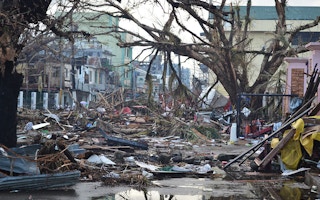As extreme weather intensified by climate change batters our societies and economies, early warning is becoming more important.
Countries are increasingly using climate information systems, which consist of data collection points that are mapped and analysed, to provide communities with scientific estimations of future climate impacts.
Their expanded use is likely as studies indicate extreme weather events are expected to occur more frequently - even assuming the Paris Agreement’s central goal of limiting global temperature rises to well under 2°C is met.
Climate effects manifest in a variety of forms — ranging from the abnormally powerful hurricanes that smashed into the Caribbean in September last year to the insidious, and equally disruptive onset of drought in Africa, most recently in South Africa.
While the impacts may differ, the destructive effects of climate change often resonate long after their onset.
The Philippines, for instance, is still dealing with the after-shocks of Cyclone Haiyan, known locally as Yolanda, which killed more than 6,000 people and reportedly dealt the biggest blow to the agricultural sector in the country’s history.
That is why the Green Climate Fund (GCF) has been stepping up its support to countries to use climate early warning systems to reduce the impacts of extreme weather.
These systems are designed to improve weather forecasting and, just as importantly, disseminate climate information to ensure communities are informed and prepared.
Wider benefits
A GCF-funded project being implemented by the Secretariat of the Pacific Regional Environment Programme (SPREP) in Vanuatu is expanding the use of climate information services in five targeted sectors: tourism, agriculture, infrastructure, water management and fisheries.
SPREP’s Simon Wilson emphasises the broad benefits climate information services can provide, right down to the grassroots level.
“Tailored meteorological and climate services can have significant multiplier benefits for decision making on a daily basis,” he said. “This can also address long-term sea level rise, and mitigate flooding impacts through infrastructure and land-use planning. Ultimately, this will help save lives and reduce economic costs.”
For the past four years, Vanuatu has been ranked the world’s most disaster-prone country, with more than 90 per cent of its infrastructure located no more than 500m from the coastline.
The experience of Vanuatu also provides an example of the positive aspects of climate disaster warning. The death toll of 11 from Cyclone Pam, which smashed into the island in March 2015, was relatively low thanks in part to the use of warning texts sent to the islanders.
The use of early warning helped to reduce the devastation, when considering that aid agencies viewed Pam to be one of the worst disasters to hit the Pacific region.
Using scientific analysis to calculate climate risks is often a core component of efforts to make societies more resilient to climate change.
“
Some see climate considerations as an increasingly essential element in making major business investments.
A GCF initiative now being implemented in Vietnam with the United Nations Development Programme (UNDP) is strengthening storm and flood protection by using information from climate assessments across all of the country’s 28 coastal provinces.
Vietnam’s vulnerability was brought into stark relief in November last year when floods following Typhoon Damrey killed at least 60, destroyed 2,000 homes, and threatened to disrupt a yearly Asia Pacific Economic Cooperation (APEC) gathering of world leaders.
Another GCF-UNDP project shows that early flood warning is not just a priority for coastal communities. Rising temperatures in northern Pakistan are turning glaciers into growing lakes which now threaten over 7 million people with flooding.
Heading off conflict
It should also be noted, however, that early warning can be more than just preparing for the sudden onset of devastation by floods and cyclones.
Joseph Intsiful, a GCF climate information specialist, believes that while prompt responses to climate disasters are essential, early warning systems are far more than just storm alerts, as they can also act as useful planning guides to boost long-term resilience.
“While freak weather events grab the news headlines, we also need to think how early warning systems can help address slow-moving climate effects such as drought,” he said.
“This is particularly important in Africa. Climate systems in the region show precipitation patterns are becoming increasingly erratic, while 95 per cent of sub-Saharan Africa’s agriculture relies on rainfall.”
More accurate predictions of rainfall can also help reduce climate change-induced conflict, added Intsiful.
“One of the biggest security challenges in West Africa is climate-related, as cattle herders move into farming lands because pasture lands they have been using become untenable with changing rain patterns,’” he said.
“With climate information and conflict early warning systems, it is possible to head off conflict before it occurs, for instance by advising that water reservoirs are installed in areas where rainfall is predicted to decline.”
Business sense
The importance of early warning systems is expected to grow. The World Economic Forum has identified the increasing prevalence and cumulative effect of extreme weather as a major risk to global stability and economic growth.
And businesses are taking note. Reinsurance group Swiss Re has found that insured losses from natural and man-made disasters worldwide in 2017 were the highest ever recorded in a single year at USD 144 billion. The main cause was the series of hurricanes that smashed the Caribbean and US coasts.
Some see climate considerations as an increasingly essential element in making major business investments. This could lead to enhanced funding by companies to support climate early warning systems as part of a country’s suite of adaptation measures.
This aspect alone is likely to increase private-sector investment in climate resilience and adaptation – which currently lags far behind private-sector investment in clean energy.
This might be a silver lining in the gathering clouds of future extreme weather.
Simon Pollock is working in communication in Green Climate Fund and is based in South Korea. This story was published with permission from Thomson Reuters Foundation, the charitable arm of Thomson Reuters, that covers humanitarian news, women’s rights, corruption and climate change. Visit news.trust.org.











